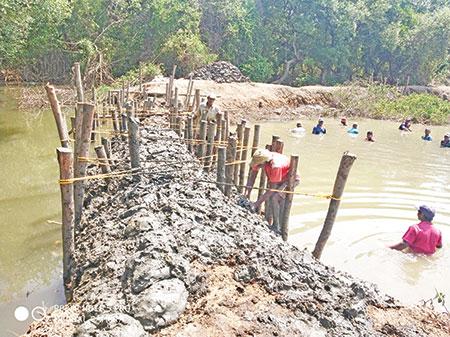
Alexandre Moniz Barbosa
Who benefits from the amendment in the CRZ, 2011 rules? It has been altered at the request of Goa, specifically a request by State Environment Minister Nilesh Cabral, through a series of communications to Union Ministry of Environment, Forest and Climate Change (MoEF&CC) proposed amendments to the CRZ notification 2011 to allow the State to exclude the HTL in khazan lands, so as to facilitate to draw a ‘practical’ Coastal Zone Management Plan (CZMP). The NCZMA found merit in Goa’s argument, and agreed that high tide line shall be restricted to the bund/sluice gate but keeping the mangrove areas as CRZ-IA. In effect, the High Tide Line in Goa where khazan lands are concerned will be demarcated along bunds and sluice gates and not to the extent of the khazan. What’s peculiar here is that at high tide the entire khazan gets filled with river water and the bunds and sluice gates are in place to stop the water from draining out of the khazans at low tide. This keeps the fish in the khazans alive. How then, does the high tide line being demarcated at the bunds and sluice gate – effectively the start of the khazan on the water side – help protect the khazans of the State?
The notification is clear that there will be no development in the khazans. It states, ‘the HTL shall be restricted up to the line long along the bund or the sluice gate and in such a case, area under mangroves arising due to saline water ingress beyond the bund or sluice gate shall be classified as CRZ-IA irrespective of the extent of the area beyond the bund or sluice gate. Such areas under mangroves shall be protected and shall not be diverted for any developmental activities.’ This effectively protects the khazan lands from any contruction activity, but what happens to the area beyond the khazan? There is no protection to this. If the high tide line ends at the bund or sluice gate area, the land beyond the khazan does not get any protection under the law, so areas on the edge of the khazan will be available for development purposes. This could lead to a cascading detrimental effect on the khazans if there come up concrete structures on the edge of the ecologically-fragile zones. The khazans need a buffer area and that buffer could be provided under the law by the high tide line being demarcated up to the inward extent of the khazans, where the waters flow during the high tide.
There exists a strong disconnect between the people and the government when it comes to matters of the environment and its protection. The latest notification is another and a prime example of this. The green lobby is already planning a legal challenge of the notification. Goa Foundation is clear on taking the legal route, and they have successfully done this in the past, putting the government on the mat on several occasions. What this will lead to is a protracted legal battle for the State paid for by the people’s money on an issue that was entirely avoidable. Where was the necessity to redraw the high tide line at a point that doesn’t serve any particular purpose in protecting the environment. The government needs to answer this question. The khazans are ancient bodies that have been created to serve a particular purpose. They have served the local populations well, their destruction will not help the local communities, but may provide new areas for development, on the edge of the khazans that were hitherto protected as buffer zones. If that is what the amendment meant to do, then it has served the purpose, but then the State Environment Department has failed in its duty of protecting the fragile lands.
For that matter the khazan lands have turned into one of the most neglected of fragile ecosystems that the State has. Just who is protecting these khazans? This month, the villagers of Chorao, with the help of the authorities, repaired three breaches in the khazan lands of their island to stop the ingress of saltwater into the land, an act that will help farmers cultivate the land this monsoon. However, not all villages that have khazans have been successful in their attempts to get the breaches in the embankments repaired, and these breaches have led to mangroves growing in khazan lands. This is a point raised by Goa Foundation, that mangroves in khazans should not be granted protection as these have come up there due to the mismanagement of the khazans. The point that Goa Foundation makes arises directly from the amended notification which states, “…the HTL shall be restricted up to the line long along the bund or the sluice gate and in such a case, area under mangroves arising due to saline water ingress beyond the bund or sluice gate shall be classified as CRZ-1A irrespective of the extent of the bund or sluice gate. Such areas under mangroves shall be protected and shall not be diverted for any developmental activties.”
It is clear that if the Coastal Zone Management Plan is going to protect the water bodies of the State, then all the khazan lands, the embankments and the sluice gates across the State have to be safeguarded in the plan. This is not negotiable and the importance of the khazans cannot be over stressed. They are an ancient marvel and have served generations of Goans, have given Goa an aspect of it identity, making the State unique, a piece of heritage that is now under threat. These lands were created centuries ago by visionaries who saw the possibility of converting marsh land into cultivable fields. They did so by reclaiming these lands in the flood plains of the major rivers and estuaries by building embankments, or bunds as they are called in Konkani, with sluice gates that control the ingress of water, so as to make the land fertile for cultivation. This ancient technology still serves well the purpose of controlling the entry of water into the land. Can we afford to lose them? The people have to wake up to the fact that the khazan lands face a major threat. These are unique parcels of land unseen elsewhere, are hyper eco-sensitive, yet, the more liberal CRZ Notification of 2018 made no mention of these, and here comes an amendment that could effectively end them. While the government managed to convince the Centre of the need for the amendment, will the local people benefit from this?
